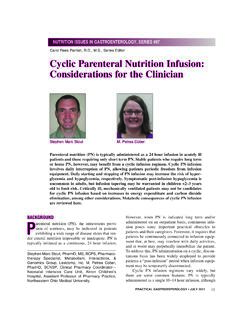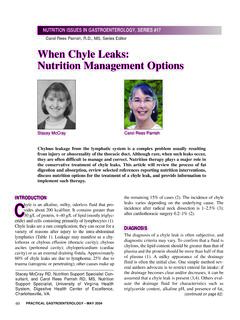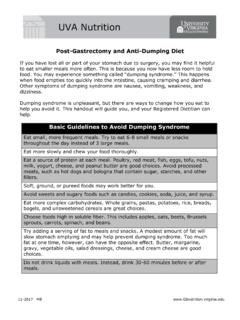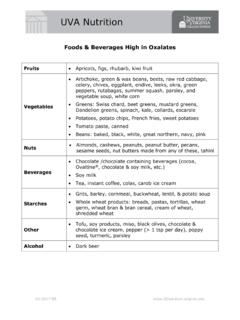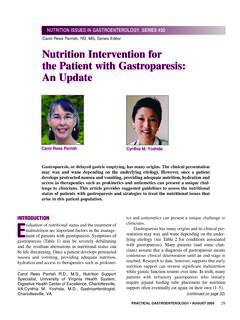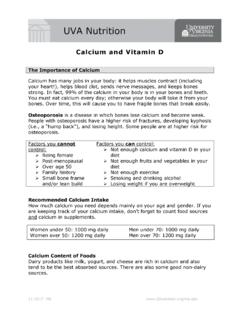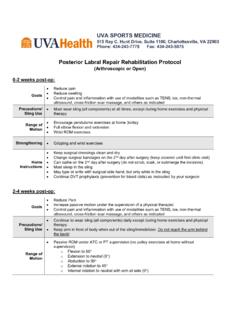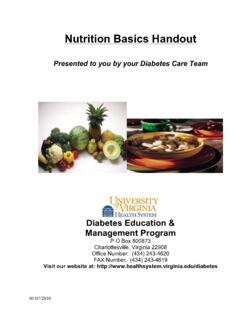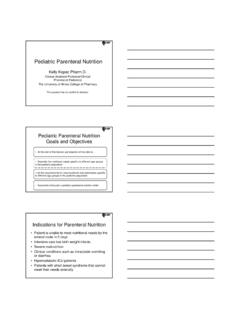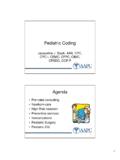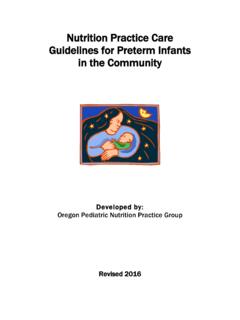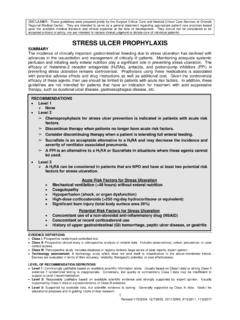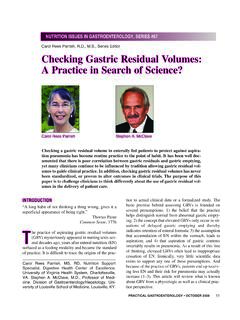Transcription of Enteral Feeding and Vasoactive Agents: Suggested ...
1 Enteral Feeding and VasoactiveAgents: Suggested Guidelines for Clinicians INTRODUCTIONE nteral nutrition (EN) is preferable to parenteralnutrition (PN) in critically ill patients due to areduction in infectious complications, a decreasedstress response with EN compared to PN, maintenanceof enterocyte viability and growth, and the promotionof a strong gut mucosal barrier (1). However, consid-erable controversy exists regarding the role of EN inhypotensive, critically ill patients requiring vasopres-sor support. Although limited data suggest that initia-tion of Enteral nutrients within 24 48 hours of criticalillness may offer outcome benefits (2), there is a con-cern that beginning EN while a patient is hemodynam-ically tenuous may compromise splanchnic perfusion(1).
2 Splanchnic perfusion can be reduced during sepsisand shock and restoration of volume status does notimmediately resolve the alterations in perfusion (3).The actions of vasopressor medications are some, resolution of hypotension and increased car-diac output contributes to improved splanchnic perfu- nutrition ISSUES IN GASTROENTEROLOGY, SERIES #78 Kristin C. Turza, , Resident in Surgery, Universityof Virginia Health System, Department of Surgery,Charlottesville, VA. Joe Krenitsky, MS, RD, NutritionSupport Specialist, Digestive Health Center of Excel-lence, University of Virginia Health System, Char-lottesville, VA.
3 Robert G. Sawyer, , Professor ofSurgery and Chief, Division of Acute Care Surgeryand Outcomes Research, Co director of the SurgicalTrauma intensive Care Unit, Director of the SurgicalNutrition Support Service, University of Virginia HealthSystem, Charlottesville, patients, including those hypotensive and vasopressor-dependent, may benefit fromenteral nutrition . Much controversy exists in the area of Enteral nutrition in the hemody-namically supported patient. Although Enteral nutrition increases GI tract blood flow, italso increases intestinal metabolic demand, and perhaps, contributes to bowel necrosis incases of impaired mesenteric perfusion.
4 However, Enteral nutrition may be undertakenwith relative safety using a thorough, four-phase process to select appropriate patientswith subsequent monitoring once Enteral nutrition has begun. Experience-guided recom-mendations are provided for initiating Enteral Feeding in this patient Rees Parrish, , , Series Editor11 PRACTICAL GASTROENTEROLOGY SEPTEMBER 2009 Kristin C. TurzaJoe KrenitskyRobert G. SawyerPRACTICAL GASTROENTEROLOGY SEPTEMBER 200912 nutrition ISSUES IN GASTROENTEROLOGY, SERIES #78 Enteral Feeding and Vasoactive Agents sion; while in others, the pharmacology of some agentscauses a decrease in perfusion (4,5).
5 The effect ofenteral nutrients on the mesentery is likewise two foldin that nutrients increase splanchnic blood flow, butthe absorption of these nutrients also increasesmucosal oxygen requirements (6,7). One review has documented that the occurrence ofmesenteric ischemia during EN is infrequent, (8). However, case reports of patientsreceiving EN who subsequently developed non -occlusive mesenteric ischemia (NOMI) are sobering,and raise important questions: Are Enteral feedings a cause, contributor, or innocentbystander in patients that have developed NOMI? Are there situations where concern for adequatemesenteric perfusion outweighs the potential bene-fits of providing EN?
6 When does a wariness of EN contribute to a delay inproviding nutrition that can result in malnutrition orinappropriate use of PN? Unfortunately, there are no large randomized stud-ies that answer these questions authoritatively. Thelimited data available oblige us to develop guidelinesfor providing EN to the critically ill patient based oninformation gleaned from case series, reviews, smallshort- term randomized studies, and bedside experi-ence. This article aims to delineate practical recom-mendations for providing EN in critically ill patients topotentially avoid the accrual of large nutrition deficitsor the complications from unnecessary PN.
7 FOUR-PHASED APPROACH First, the practitioner considers a patient s relative riskfor EN- related bowel complications. This evaluationincludes a review of chronic conditions and pre- hospitalhealth and medications, as certain conditions and med-ications may predispose the patient to NOMI. Second, athoughtful analysis is performed of the patient s physio-logic state while on vasopressors; stable low -dose pres-sor requirements in the face of hemodynamic stabilitywithout the need for transfusion, suggest a lower likeli-hood of NOMI. Third, once the benefits are determinedto outweigh the risks of beginning EN, the type ofnutrition formula should be carefully chosen.
8 Enteralformulas with modest osmolality and minimal fibermay help minimize complications related to the feedingformula (6). Fourth, after the initiation of EN, monitor-ing must be done for clinical signs of distress. Serialabdominal exams, gastric residual checks and periodicTable 1 Phases for progressing with Enteral nutrition in vasoactiveagent-dependent patientsPhase I: Evaluate patient's pre-morbid medical and nutritional historyA. Patient risk factors predisposing to ischemic gut Diabetes, cardiovascular disease MedicationsB. Potential benefit for individual Poor pre-operative nutritional status Higher metabolic demand in any post-surgical statePhase II: Evaluate current physiologic statusA.
9 Hemodynamic state with respect to Vasoactive medication Stable pressor requirement without transfusion requirement Epinephrine 5 mcg/min, norepinephrine 5 mcg/min,dopamine 10 mcg/kg/min, vasopressin units/min MAP greater than 60 mm HgB. Other measures of physiologic stability Close monitoring of vital signs every hour Hourly urine output Laboratory values: lactate, base deficitPhase III: Logistics of initiating Enteral nutritionA. Route to be used to initiate Enteral nutrition PEG tube Jejunostomy tube Dobhoff-type oro- or nasogastric tube or other oro- or nasogastric sump-type tubeB. Type of nutritional supplement standard-polymeric without fiber (<700 mOsm)Phase IV: Post-initiation clinical monitoringA.
10 Serial abdominal exams every 8 12 hoursB. Gastric residual checks every 6 hoursC. Laboratory studies Lactate, hemoglobin and hematocrit every 6 12 hours,WBCD. Radiographic monitoring per clinician discretion Serial abdominal x-ray CT scan(continued on page 15)radiographic imaging help ensure that early signs ofgastrointestinal distress are detected and can be pre-vented from progressing to a critical stage. Following are three case reports that illustrate theabove four phased approach (Table 1). Each patientwas deemed a reasonable candidate for EN in spite oftheir vasopressor requirements. Subsequent and vigi-lant monitoring were utilized to ensure that signs ofsignificant gut dysfunction were identified early andintervened upon as necessary.
